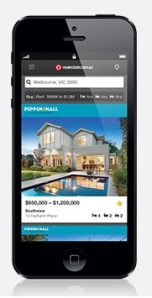The new iPhone & iPod application for RealEstate.com.au turned out a real winner for the ASX-listed REA Group with their award for ‘Best mobile expanded service or application’ at the 2012 Australian Mobile Awards.
This joins their suite of mobile applications providing access to their property services for users looking to buy, rent or find share accommodation. It also offers users a wide range of complementary products from loan calculators, renovation tips, property reports, virtual tours and map functions.
This award is a bonus for their business but what they have achieved is worth analysing by other business’ who want to capitalise on the thriving mobile application space and develop a ‘rich internet application (RIA)‘. This success can be explained by their ‘rich user experience (RUE)‘, a pattern which says Web 2.0 success comes from giving users a high-function experience that is ideally suited to their needs and delivered in a high-performance format.
Best Practice strategies
RealEstate.com.au strongly delivers in all best practice areas of their mobile applications:
* Delivers a function-rich application with good performance like a desktop application combined with platform independence and multiple interfaces to complementary applications,
* Targets the users-needs and offers complementary functions like advice, calculators and maps in an easy-to-use and integrated service,
* Offers both comprehensive searches based on property attributes as well as site structure to highlight functions for buying, selling, sharing and advertising,
* Allows content addressability to link to properties, connect with agents, and use functions like email and virtual tours,
* Remembers users preferences and offers features like saved searches and email alerts giving users an adaptive and personalised experience.
User Interface issues
While RealEstate.com.au delivers a rich user experience, they seem to hit some common interface issues:
* the sheer volume of features can clutter the user interface but this doesn’t seem to cause performance issues,
* the useful map functions occur at a number of layers of the application but they don’t seem to flow seamlessly.
Benefits to the business
Their online and mobile applications offer RealEstate.com.au some real business benefits:
* higher user satisfaction equates to increased visits, improved sales and enhanced satisfaction and creates true business value,
* extensive functions and complementary services attracts a broad range of users and encourages regular, repeat and extended visits,
* wide range of product offerings can sustain visits even when parts of the business experience downturns.
Their impressive February 2013 statistics are a testament to their success:
- “had 18,914,431 total visits, which was 11,225,360 more visits than the closest competitor
- generated 103 page views per person, which was 53 more page views per person than the number two competitor
- visitors stayed on realestate.com.au for an average of 9 minutes and 27 seconds, which is 3:30 minutes longer than they stayed on the closest competitor’s property site”
Their parent company, REA Group, attributes their recent success to the strong uptake in mobile applications. Any business that wants to achieve that level of success in social media applications should aim to offer their customers a ‘rich user experience’ and maybe learn from others experiences.









